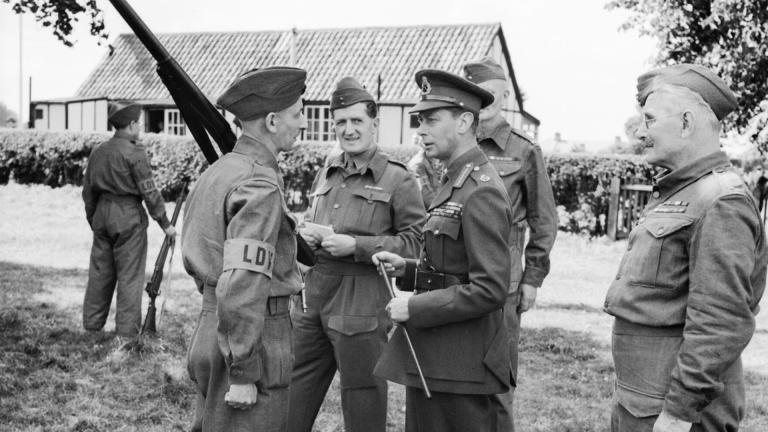
Read more about WW2

If Dad’s Army painted the Home Guard as lovable, well-meaning amateurs, the real story tells of citizens who transformed comedy into courage. And if you know the Sky HISTORY bunch, you’ll know we love to uncover the real story.
Let’s peer behind the curtain of the beloved sitcom and into the lived reality and legacy of WWII Britain’s last line of defence.
In May 1940, facing the looming threat of German invasion, Britain raised the Local Defence Volunteers (LDV) – soon renamed the Home Guard – to plug the gap left by thousands of men already overseas. Comprised of volunteers too young or too old to be sent to the frontline, or otherwise exempt from regular service, the Home Guard quickly became a force of over 1.5 million men. By late 1940 the armed citizen militia was mobilised across 1,200 battalions.
In the sitcom, rifles were often wooden, and commands were comedic. In real life, the Home Guard’s early days were defined by improvisation. Few received official weapons initially. Instead, Molotov cocktails, homemade grenades and pikes filled the armoury gap. Yet, under the leadership of visionaries like Tom Wintringham, volunteers trained tirelessly to learn guerrilla tactics and urban defence, rather than basic marching drills.
By 1942, the Home Guard was operating anti-aircraft guns, coastal artillery and rocket batteries. They even engaged German planes with machine guns and shot down multiple Luftwaffe aircraft and V-1 flying bombs. Basically, they delivered genuine assistance to frontline troops at a critical moment in the war.
The Home Guard’s secret tasks included digging defences, guarding supply routes and preparing for invasion.
While Dad’s Army focused on platoon squabbles and cadenced drills, the real Home Guard handled urgent missions during the Blitz. The bomb-laden streets of London were no sitcom set.
During the Blitz the German Luftwaffe dropped around 20,000 bombs on the city. The Home Guard was regularly deployed to locate unexploded bombs and evacuate civilians: missions that tragically claimed over 1,200 lives across the Home Guard during WWII.
The stakes were far higher than the hit British sitcom starring Arthur Lowe, Clive Dunn, John Laurie and Ian Lavender would have you believe.
Stationed at factories, rail bridges, ammunition depots and other strategic sites, the Home Guard wasn’t just a last-ditch invasion force. They kept Britain’s infrastructure intact during crisis and the very real threat of German invasion. They also prevented local panic during emergencies, dealing with civilians and allowing police and military units to focus on combat operations.
Much like the sitcom’s colourful cast, the real Home Guard counted notable figures among its ranks. The likes of author George Orwell (who wrote Animal Farm), Winnie-the-Pooh creator A. A. Milne and The Chronicles of Narnia mastermind C. S. Lewis all served as volunteers.
Jimmy Perry, the co-creator of Dad’s Army, joined the LDV at 16 and drew on his experiences (including a crusty lance corporal modelled on a real-life older Home Guardsman) for his scripts.
The Home Guard reminds us that wars are often shaped not by mouthy generals, but by everyday people on the front line.
The BBC sitcom was, and still is, loved by Brits. But it is worth noting the differences between fiction and reality. Dad’s Army leaned into warmth and comedy, portraying mismatched platoons bonding over mishaps.
In contrast, the actual Home Guard was diverse, disciplined and essential. Its members officially ranged from 17 to 65 years of age, working regular jobs by day and training at night. However, the rules were sometimes bent. One platoon included a 14-year-old and several men in their eighties.
Equipment evolved from shotguns and fishing reels to more formal military issue. And training? Far from the bungling portrayed on screen, some units trained intensively for guerrilla tactics and hands-on warfare, if necessary.
The Dad’s Army bop featured gaudy uniforms and theatrical mishaps, but the real Home Guard was far more serious. They protected real lives and their steady presence during Britain’s darkest hours steadied a nation teetering on the brink.
As the sitcom famously put it, 'Don’t panic!'
And yet the real Home Guard remained poised, steadfast and most importantly, panic-free.
If you’re captivated by the stories behind the stories, sign up for the Sky HISTORY newsletter. Expect a weekly dose of history, straight to your inbox.